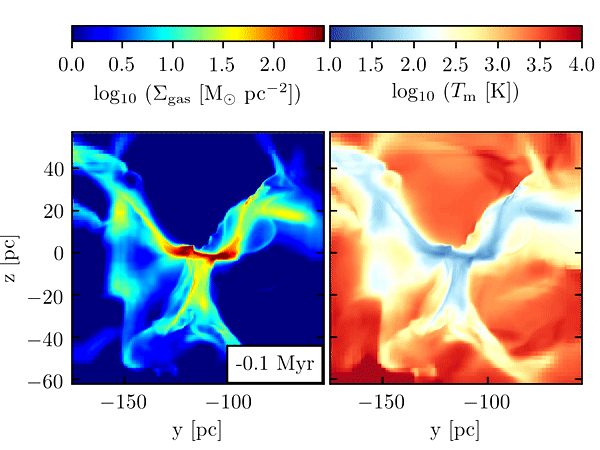Numerical simulations of a molecular cloud with star formation and ionising radiation
Molecular clouds form out of the multi-phase interstellar medium (ISM). These conglomerations of dense gas are birthplaces of stars. Massive stars release enormous amounts of ionising radiation.This source of stellar "feedback" influences the subsequent evolution of the parental cloud and imparts turbulent motions to the surrounding ISM.
In the movie, we present our first sub-parsec (spatial resolution $0.122$ pc), radiation-hydrodynamic simulation of a molecular cloud, which forms self-consistently out of a supernova-driven model of the Galactic disc, including self-gravity and a chemical network coupled with gas (self-)shielding and ionising radiation. The cloud forms stars, the massive of which (usually more massive than 8 solar masses; white stars) photoionise their surroundings. Stars less massive than 8 solar masses are not sources of powerful ionising radiation, and we plot them as black circles. The photoionising radiation first heats the cloud to $10^4$ K, and gradually reshapes and disperses it as shown in the integrated density (left panel) and the mass-weighted temperature (right panel) plots.
A comparison with a control run without feedback reveals a global cloud star formation efficiency of less than 10% (a factor 4 less than without radiative feedback). Despite these low efficiencies, feedback triggers additional star formation across the cloud. Therefore, a much larger region of the cloud is affected by radiation, which causes more destruction to the cloud. We also find that the time scale on which the clouds are dispersed sensitively depends on the cloud substructure and in particular on the amount of gas at high visual extinctions. The damage of radiation done to the highly shielded cloud is delayed.
Our results strongly support the importance of ionising radiation from massive stars for explaining the observed low star formation efficiency of molecular clouds.
